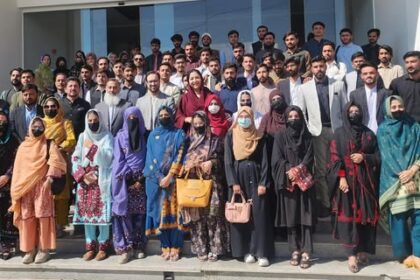
Millions of Children Deprived of Education and Training
By: Zaheer Ahmed Awan
In every developed society, governments consider their children to be the foundation of their future. Nations invest their best resources in the education, training, and moral development of the next generation. Education is not just a way to earn a living—it shapes personalities, strengthens national unity, promotes tolerance, and drives economic progress. Unfortunately, in Pakistan, the reality is completely different. Millions of our children are being pushed out of meaningful education and proper upbringing, and the state mostly looks the other way. A very large portion of Pakistani children are studying in religious seminaries (madrasas). These children come from millions of poor households that cannot afford school fees, uniforms, textbooks, and other expenses. Madrasas provide them free shelter, food, religious training, and a form of basic literacy. They operate largely on donations and individual charity. They fill a void that the government has failed to address. In any responsible country, free education would not be left to private charities, nor would the future of children depend on voluntary donations. But in Pakistan, this has become a normal practice. As long as a child is enrolled somewhere—even if the education has no relevance to modern life—the state feels satisfied. In developed nations, governments treat every child as their own child. They do not divide the children of the rich and the poor. They believe that the children of millionaires and the children of laborers both belong to the nation. They must have equal opportunities. Europe, Japan, South Korea, Malaysia—these are clear examples. Japan was destroyed after the Second World War. Entire cities were wiped out, their economy collapsed, and their infrastructure was in ruins. Instead of spending on palaces, protocol, or class privileges, the Japanese government invested in one thing: education. They focused not only on buildings, but on character development, scientific thinking, discipline, and collective national identity. Today, Japan is one of the most advanced economies in the world. South Korea faced similar destruction in the 1950s. It was poorer than many African nations. But the government made education the central pillar of national rebuilding. They gave every child at least twelve years of strong, compulsory education—without discrimination or status. Today South Korea is a global leader in technology, manufacturing, and innovation. Now compare this with Pakistan. Here education is divided by class and privilege. There is one separate educational universe for elites—private international schools, O/A Level academies, modern campuses with air-conditioned classrooms, expensive laboratories, professionally trained teachers, and a guaranteed path to higher careers. These schools are only accessible to the rich. No ordinary citizen can afford them. The second category is private local schools, mostly catering to middle-class families. Fees are high but not as high as elite schools. Even then, a middle-class household must sacrifice a large portion of monthly income just to keep their children enrolled. The third category is government schools. These schools lack proper resources, trained teachers, modern teaching standards, and long-term planning. Children mostly attend to mark presence; real learning is rare. Below all these layers are millions of children who never enter any school at all. Their parents struggle to survive. They do not have enough money for food, let alone books. These children start working at a young age—cleaning shops, washing cars, doing house labor, or helping their parents in daily wage work. Others are sent to madrasas only because they can live and eat there without expense. Madrasas provide shelter and survival. That is why poor families choose them—not because they reject education, but because they simply cannot afford it. Government schools receive billions in funding each year. There are monitoring systems, attendance apps, supervision committees, and performance reports. But these systems only benefit children who are already inside those schools. The state never asks:
What about the children who never entered? What about millions who are outside? Are they not Pakistan’s children? Who will take responsibility for their future? They are invisible. They do not appear in policy meetings, curriculum boards, or budget speeches.
Even poorer countries have solved this problem better than us. Bangladesh, once known for poverty and weak governance, treated education as a national emergency. From the 1990s onward, they launched massive primary education programs with international cooperation. They hired female teachers in huge numbers, provided stipends, school meals, and free books. Today Bangladesh’s literacy rate and primary school enrolment are higher than Pakistan’s. Malaysia reformed its madrasa system. Instead of eliminating it, they integrated it with modern education. Children enrolled in religious institutions also study mathematics, science, computer skills, and social sciences. Their abilities are not restricted to recitation alone. They can enter modern professions, research fields, or higher education just like students of regular schools. As a result, Malaysia turned its youth into a productive force in the national economy.
Pakistan still has no unified education strategy. Madrasa students, government school students, and private school students live in three different worlds. Their identities are different, their values are different, and their futures are different. The government does not provide resources to madrasas, nor does it set standards. Their students are not given a roadmap or professional opportunities. These institutions are expected to survive on charity. A charity-based approach cannot support millions of children, nor can it transform them into engineers, doctors, computer scientists, or entrepreneurs. Millions of talented children are losing their potential. They could have been doctors saving lives, engineers building infrastructure, scientists developing new technology, military officers defending the nation, or innovators creating jobs. Instead, many end up as laborers, assistants, or factory workers earning daily wages. Not because they lack intelligence, but because their parents lacked resources. Education should not be a privilege. It should be a national right. If Pakistan wants to survive the future, it must abandon this class-based structure. The children of the rich and the poor must sit in the same classrooms. The same curriculum, same teachers, same exams, same opportunities. Only then will this nation stand united.
The world has changed. The 21st century belongs to nations that value knowledge, technology, innovation, and human development. Countries that invest in their children grow. Countries that ignore them remain trapped in poverty and chaos. Pakistan must decide are our 25–30 million children just numbers in a government file? Or are they the future of this country?
Read in Urdu: تعلیم سے محروم کروڑوں بچے کس کے ہیں؟











